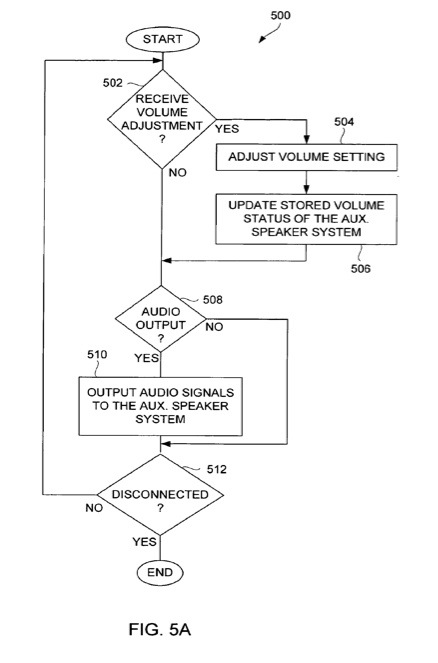Per a new Apple patent (number 20120070017) at the U.S. Patent & Trademark Office, Apple is working on ethods and systems for improved interaction between media devices and accessory devices.
In one embodiment, the improved interaction can operate to configure a user interface of a media device dependent on the type or condition of an accessory device. In the same or another embodiment, the improved interaction can exchange status information between a media device and an accessory device that can influence operation of either or both of the devices.
The invention pertains to methods and systems for improved interaction between media devices and accessory devices. In one embodiment, the improved interaction can operate to configure a user interface of a media device dependent on the type or condition of an accessory device. The configuration of the user interface can be automatically performed when the media device is connected with the accessory device. In the same or another embodiment, the improved interaction can exchange status (or state) information between a media device and an accessory device that can influence operation of either or both of the devices. The exchange of the status information can be automatically performed while the media device is connected with the accessory device.
Here's Apple's summary of the invention: "The invention can be implemented in numerous ways, including as a method, system, device, apparatus (including graphical user interface), or computer readable medium. Several embodiments of the invention are discussed below.
"As a method for operating a portable media device, one embodiment of the invention includes at least the acts of: detecting attachment of an auxiliary device to the portable media device; obtaining auxiliary device information from the auxiliary device after detecting that the auxiliary device is attached to the portable media device; and thereafter configuring the portable media device to operate in accordance with the auxiliary device information.
"As a method for operating a portable media device, another embodiment of the invention includes at least the acts of: detecting attachment of an auxiliary speaker system to the portable media device; obtaining volume status information from the auxiliary speaker system after detecting that the auxiliary speaker system is attached to the portable media device; and thereafter configuring a volume setting on the portable media device based on the volume status information.
"As a method for operating a portable media device, still another embodiment of the invention includes at least the acts of: obtaining volume status information from an auxiliary speaker system that is operatively connected to the portable media device; receiving a user input that alters the volume status information; processing the user input at the portable media device to produce altered volume status information; and causing the volume status information stored in the auxiliary speaker system to be updated based on the altered volume status information.
"As a computer readable medium including at least computer program code for operating a portable media device, one embodiment of the invention includes at least: computer program code for detecting attachment of an auxiliary device to the portable media device; computer program code for obtaining auxiliary device information from the auxiliary device after the computer program code for detecting detects that the auxiliary device is attached to the portable media device; and computer program code for configuring the portable media device to operate in accordance with the auxiliary device information.
"As a computer readable medium including at least computer program code for operating a portable media device, another embodiment of the invention includes at least: computer program code for detecting attachment of an auxiliary speaker system to the portable media device; computer program code for obtaining volume status information from the auxiliary speaker system after the computer program code for detecting detects that the auxiliary speaker system is attached to the portable media device; computer program code for configuring a volume setting on the portable media device based on the volume status information; computer program code for receiving a user input that alters the volume status information; computer program code for processing the user input at the portable media device to produce altered volume status information; and computer program code for causing the volume status information stored in the auxiliary speaker system to be updated based on the altered volume status information.
"As a portable media delivery system, one embodiment of the invention includes a portable electronic device and a speaker system. The portable electronic device is operatively connectable to the speaker system and includes at least (i) a media storage device that stores media content for one or more media items, and (ii) a media presentation module that retrieves media content for at least one of the media items from the media storage and causes the media content to be presented for a user of the portable electronic device.
"The speaker system stores at least a device identifier and a system status information. When the speaker system is operatively connected to the portable electronic device, the portable electronic device can receive the device identifier and the system status information from the speaker system, and then configure a user interface associated with the portable electronic device based on at least the system status information.
The inventors are Jesse L. Dorogusker, Donald J. Novotney, Scott Krueger, Jeff Hammerstrom, Greg Marriott and Greg Lydon.
Another Apple patent (number 20120072807) shows that Apple is working on systems and processes may be used to retrieve metadata from a nonvolatile memory of a portable device and transmit the retrieved metadata to an external host. Metadata may be analyzed using the external host and/or at least a portion of the metadata may be modified based on the analysis. Modified metadata may be transmitted from the external host to a memory controller of the host. Michael J. Cornwell, Christopher P. Dudte and Nir Jacob Wakrat are the inventors.














